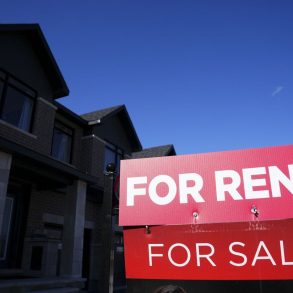After plummeting more than 40% since February, home sales are showing signs they may be reaching a bottom.
In October, home sales rose for the first time since before the interest rate hikes began, rising 1.3% from September. They remain down 36% compared to last October, according to the Canadian Real Estate Association (CREA).
“October provided another month’s worth of data suggesting the slow down in Canadian housing markets is winding up,” said Shaun Cathcart, CREA’s senior economist. “Sales actually popped up from September to October, and the decline in prices on a month-to-month basis got smaller for the fourth month in a row.”
In seasonally adjusted terms, home prices were down 1.2% from September, marking the smallest decline since June, CREA said.
The actual (not seasonally adjusted) price stood at $644,643 in October. That’s up 0.7% from September, but down 9.9% from a year ago.
New listings were up 2.2% month-over-month, CREA noted, “with gains in the Greater Toronto Area (GTA) and the B.C. Lower Mainland offsetting declines in Montreal and Halifax-Dartmouth.”
Months of inventory continued to improve slightly, rising to 3.8 months. That’s up from 3.7 in August and a record low of 1.6 earlier this year.
Removing the high-priced markets of the Greater Toronto and Vancouver areas, the average price stands at $519,643.
Cross-country roundup of home prices
Here’s a look at select provincial and municipal average house prices as of October, with their annual and monthly changes.
| Location | Average Price | Annual price change | Month-over-month change |
| Quebec | $475,577 | +1.2% | -0.9% |
| B.C. | $927,205 | -3.7% | +0.6% |
| Ontario | $835,090 | -8.5% | -0.1% |
| Alberta | $430,964 | +1.9% | -0.2% |
| Halifax-Dartmouth | $484,800 | +9.5% | -3% |
| Barrie & District | $794,800 | -4.8% | -0.8% |
| Greater Toronto | $1,098,200 | -1.3% | +3% |
| Victoria | $915,300 | +11.5% | -2% |
| Greater Vancouver | $1,148,900 | +2.1% | +3.3% |
| Greater Montreal | $504,800 | +2.8% | -3.6% |
| Calgary | $513,000 | +10.3% | -0.7% |
| Ottawa | $630,800 | +0.8% | -2% |
| Winnipeg | $337,400 | +1.6% | -0.7% |
| St. John’s | $318,200 | +5.5% | +1.9% |
| Edmonton | $372,400 | -0.6% | -2.6% |
It’s important to note that some of the movements in the table above may be somewhat misleading, since average prices simply take the total dollar value of sales in a month and divide it by the total number of units sold. The MLS Home Price Index, on the other hand, accounts for differences in house type and size.
On a seasonally adjusted basis, the MLS HPI for Toronto has fallen 11% since February, while Vancouver’s HPI is down 5.3% from its peak in March.
Housing downturn: the beginning of the end?
The data suggests this current downturn may be entering the “latter stages of its cyclical downturn,” according to Robert Hogue at RBC Economics.
“The pace of decline is now slowing—there was even a tiny monthly increase in home resales nationwide in October—marking a notable shift from the deep fall in activity that took place over the spring and summer,” he wrote. “While we continue to think an inflection point is some ways off, it does suggest most of the price correction is likely behind us—at least for Canada as a whole.”
TD economist Rishi Sondhi agreed, writing, “Absent further rate hikes, one could make the case that Canadian housing demand is approaching a bottom.”
But with further Bank of Canada rate hikes expected, Sondhi says that will weigh on demand and prices. “In fact, they should continue dropping through the early part of next year,” he said.
And while Hogue sees the worst of the price decreases already behind us, he adds that rising interest rates and further deteriorating affordability will keep market activity “quiet” until early 2023, with prices bottoming sometime in the spring.
“The market downturn may be in a late stage but it doesn’t mean things are about to heat up again,” he noted. “We expect high— and still-rising—interest rates will continue to challenge buyers for some time. This will keep activity quiet for a while longer even if it stabilizes near current levels.”







